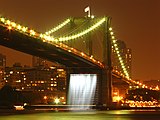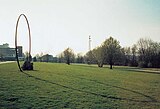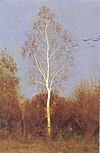Site-specific art


Site-specific art is artwork created to exist in a certain place. Typically, the artist takes the location into account while planning and creating the artwork. Site-specific art is produced both by commercial artists, and independently, and can include some instances of work such as sculpture, stencil graffiti, rock balancing, and other art forms. Installations can be in urban areas, remote natural settings, or underwater.[1][2][3][4][5][6]
History[]
The term "site-specific art" was promoted and refined by Californian artist Robert Irwin[7][8] but it was actually first used in the mid-1970s by young sculptors, such as Patricia Johanson, Dennis Oppenheim, and Athena Tacha, who had started executing public commissions for large urban sites.[citation needed] For Two Jumps for Dead Dog Creek (1970), Oppenheim attempted a series of standing jumps at a selected site in Idaho, where "the width of the creek became a specific goal to which I geared a bodily activity," with his two successful jumps being "dictated by a land form."[9] Site specific environmental art was first described as a movement by architectural critic Catherine Howett and art critic Lucy Lippard.[citation needed] Emerging out of minimalism,[10] site-specific art opposed the Modernist program of subtracting from the artwork all cues that interfere with the fact that it is "art",[11]
Modernist art objects were transportable, nomadic, could only exist in the museum space and were the objects of the market and commodification. Since 1960 the artists were trying to find a way out of this situation, and thus drew attention to the site and the context around this site. The work of art was created in the site and could only exist and in such circumstances - it can not be moved or changed. Site is a current location, which comprises a unique combination of physical elements: depth, length, weight, height, shape, walls, temperature.[12] Works of art began to emerge from the walls of the museum and galleries (Daniel Buren, Within and Beyond the Frame, John Weber Gallery, New York, 1973), were created specifically for the museum and galleries (Michael Asher, untitled installation at Claire Copley Gallery, Los Angeles, 1974, Hans Haacke, Condensation Cube, 1963–65, Mierle Laderman Ukeles, Hartford Wash: Washing Tracks, Maintenance Outside, Wadsworth Atheneum, Hartford, 1973), thus criticizing the museum as an institution that sets the rules for artists and viewers.[13]
Jean-Max Albert, created Sculptures Bachelard in Parc de la Villette related to the site, or Carlotta’s Smile, a trellis construction related to Ar. Co,’s architecture Lisbon, and to a choreography in collaboration with Michala Marcus and Carlos Zingaro, 1979.[14]
When the public debate over Tilted Arc (1981) resulted in its removal in 1989, its author Richard Serra reacted with what can be considered a definition of site-specific art: "To move the work is to destroy the work."[15]

Examples[]
Outdoor site-specific artworks often include landscaping combined with permanently sited sculptural elements; it is sometimes linked with environmental art. Outdoor site-specific artworks can also include dance performances created especially for the site. More broadly, the term is sometimes used for any work that is more or less permanently attached to a particular location. In this sense, a building with interesting architecture could also be considered a piece of site-specific art.
In Geneva, Switzerland, two Contemporary Art Funds of the city have been looking to integrate art into the architecture and the public space since 1980.[16] The Neons Parallax project initiated in 2007 was conceived specifically for the Plaine de Plainpalais, located in the heart of the city. The challenge of the artists invited was to transpose commercial advertising signs of the harbour into artistic messages.[17] The project has received the Swiss Prix Visarte 2017.
Site-specific performance art, site-specific visual art and interventions are commissioned for the annual Infecting the City Festival in Cape Town, South Africa. The site-specific nature of the work allows artists to interrogate the contemporary and historic reality of the Central Business District and create work that allows the city's users to engage and interact with public spaces in new and memorable ways.[18]
Gallery[]

Robert Smithson, Spiral Jetty from atop Rozel Point, 2005.

Side effect X, Eberhard Bosslet; Tias, Lanzarote, 2008.

View of an installation from Strandbad Seedorf, Switzerland, 2015.

A rock balance, England, 2013.

The Globe, Knockan Crag National Nature Reserve, Scotland, 2007.

Olafur Eliasson's Waterfalls under the Brooklyn Bridge, 2008.

Site specific dance by Blue Lapis Light at the Texas State History Museum in Austin, Texas, 2010.

O, Die Stimme in der Kunst, Klinikverwartung, Milton Becerra, Germany, 1989.
See also[]
- Aerial dance
- Digital art
- Ecological art
- Environmental art
- Environmental sculpture
- Greenmuseum.org (online museum of environmental art)
- Independent public art
- Karriere Bar
- Land art
- Land Arts of the American West
- Lock On art
- Plop art
- Rock balancing
- Street Installations
- Public art
- Yarn bombing
References[]
- ^ http://www.lataco.com Interview with Rafael Schacter, Author of The World Atlas of Street Art and Graffiti.
- ^ https://www.nytimes.com Aerosol Art.
- ^ http://www.filippominelli.com Filippo Minelli "Silence/Shapes."
- ^ Rafael Schacter, author of "The World Atlas of Street Art and Graffiti", September, 2013; ISBN 9780300199420.
- ^ http://www.brooklynstreetart.com Rafael Schacter and His "World Atlas of Street Art and Graffiti."
- ^ https://www.youtube Gravity Glue 2015; (Underwater Rock balance at 3:55).
- ^ Butterfield, Jan (1993). The art of light + space. New York: Abbeville. ISBN 1558592725.
- ^ Hankins, Evelyn (2016). Robert Irwin: All the Rules Will Change. Hirshhorn Museum and Sculpture Garden. ISBN 978-3791355146.
- ^ Kaye, Nick (2000). "Embodying Site: Dennis Oppenheim and Vito Acconci". Site-Specific Art: Performance, Place and Documentation. New York: Routledge. pp. 154. ISBN 0-203-13829-5.
- ^ Kwon, Miwon (2002). One Place After Another: Site-Specific Art and Locational Identity. Cambridge (Massachusetts), London: MIT. p. 3. ISBN 0-203-13829-5.
- ^ Kaye (citing O'Docherty's Inside the White Cube, 1986), p. 27
- ^ Kwon, p.3
- ^ Kwon, p. 13
- ^ "Abecedário — AR.CO — Centro de Arte e Comunicação Visual". www.arcoabecedario.pt. Retrieved 2018-10-26.
- ^ Kaye, p. 2
- ^ "Missions | Fonds d'art contemporain | Ville de Genève : Sites des institutions". institutions.ville-geneve.ch (in French). Retrieved 2018-01-05.
- ^ Neons Parallax
- ^ "Infecting The City - Africa Centre". Africa Centre. 2014-03-28. Retrieved 2018-01-05.
External links[]
 Media related to Site-specific art at Wikimedia Commons
Media related to Site-specific art at Wikimedia Commons
- Visual arts genres
- Artistic techniques
- Installation art
- Contemporary art
- Sculpture
- Land art
- Landscape design history
- Landscape architecture
- Postmodern art








